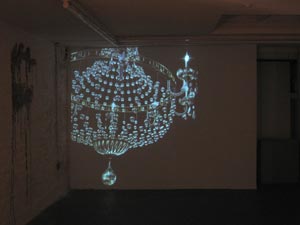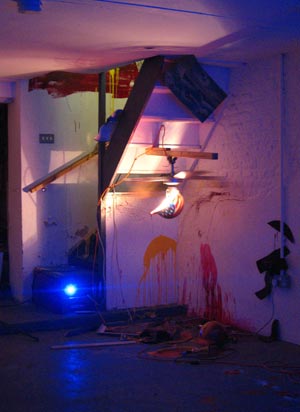Since opening last January, Meals & SUVs has joined London’s relatively small community of independent, artist-run spaces. From a gallery just off Kingsland Road, Meals & SUVs looks beyond the commercially certified art scenes in New York and LA to show artists like Austin-based Erick Michaud alongside other young, mostly UK-based artists.
Michaud’s Herald of Doom (2005) sets the tone for the current exhibition, The Devil in Miss Jones. For this film, Michaud donned a black robe and horned mask with the name “PSUCHE” taped across the forehead in order to preach from atop a thundercloud. Lightning bolts from Michaud’s theatrical podium stab downward across an orange sky as he begins: ‘shut up, everybody shut up. I’ve been given a message from the powers that be. Pay attention.” Michaud then bends down to turn on the music (a pulsing synthesizer soundtrack) and to check his notes before continuing: “This is the beginning of the end.” To the beat of the music and blinking karaoke-like subtitles, he explains: “There is no culture / I am culture. There is no fear / I am fear. There is no past / I am the past. There is no future / I am the future….” The apocalyptic message is comical, any power of awe or intimidation entirely frustrated by Michaud’s goofy lo-tech presentation.
Creating a similar type of comic mischief with otherwise humorless material, Beate Bloe’s film Filosofiska Rummet [The Philosophy Room] (2006) presents a scene of three philosophers-cum-cultural commentators discussing good and bad taste. In this animation of Bloe’s schematic black and white drawings, one of the characters in the film offers “poo” as an example of something that could be, across the board, considered in bad taste. But the assertion is countered by her colleague’s argument that “poo could very well be used as a measure of good taste – in middle class homes.”
Meanwhile, Shane Bradford perpetuates further cultural meltdown in the yellowing, dog-eared paperback copies of American literary classics that he has dipped in multiple layers of colorful plasticine paint. The pages of Anthony Evan’s Goldfish, Truman Capote’s In Cold Blood and Jack Kerouac’s On the Road are all thus methodically censored: permanently sealed shut in the act of creating bright and shiny objects.
Work by Aoife Collins (one of the curators of this exhibition) also contemplates the demise of male literary figures. Her drawings for Cheek to Cheek (2006) pluck moments from the biographies of Arthur Rimbaud, Friedrich Nietzsche and Ezra Pound. Depicted with precision and a hint of spite, these authors of the gilded age are shown shot down in the street or stricken with illness. As expressed in the work of both the artists and the curators of this show, angst is no longer a symptom of rebellion, but a rather constipated subject in itself.
A little further east, Tom Humphreys” project space, Flaca, has hosted a series of local and international collaborations since opening its doors on Broadway Market in 2003. For the current exhibition, Reasonable, curator Jennifer Davy has called on three fellow Texans to present new work. On the ground floor room of the tiny shopfront space, Luz María Sánchez has mounted four speakers in a line across the wall. In this piece, 2487 (2006), we hear Sánchez reciting the names of people who have died trying to cross the border between Mexico and the US: “Guadalupe Flores Martinez. Olivia Cruz Juarez. Juan Pablo Cordoba.” Each name lingers with an uncanny resonance — both foreign and familiar, everyone and no one.
Literally ripping pages from the October 9, 2006, issue of London’s new free evening newspaper, London Lite, Rae Culbert’s installation We don’t Fear The Stars of Lust (2006) takes its title from two separate headlines splashed across a photo spread. English footballers are cued with the line “We don’t Fear” while the ‘stars of Lust” are pictured as two reality TV stars entwined on a tropical beach. As if battling this infuriatingly superficial publication, Culbert has pulled the paper apart, then duct-taped it to the walls and stairwell, smearing the pages with red and yellow and black paint. But Culbert’s interest in this particular issue becomes clear downstairs when the work climaxes at a full-page advertisement for a mock documentary about the assassination of George W. Bush. Produced by UK broadcaster Channel 4, the tag-line for the program reads, “George W. Bush: 6 July 1946 — Tonight 9pm.”
The packets of Marlboro Reds and cans of Stella Artois and corned beef that Culbert has strewn across the work indicate a truly frenzied encounter with British media. The artist has flung schoolhouse globes, tacky landscape paintings and construction helmets emblazoned with the American flag down the stairs, leaving some smashed and others dangling from the railings. One globe has rolled across the basement floor (over the photograph of W collapsing at his bodyguards” feet) to meet the mesmerizing pendulum in Guy Hundere’s film Tremble (2006). The surprisingly graceful interplay between these two works is a testament both to Culbert’s and Hundere’s artistic generosity and to Jennifer Davy’s sensitivity to the dialogue between these artists.
Silently echoing the somber pace of Sanchez’s sound installation, Hundere’s film, made with 3D animation technology, depicts a delicate, crystalline chandelier as it rhythmically sways and quivers. Perhaps it is disturbed by the rumblings of an earthquake, but more likely it is being shaken by some human unrest — bombs are falling on the TV screen and someone in the apartment above is raving mad.
Images courtesy the writer.
Lillian Davies is an American writer living in London.






